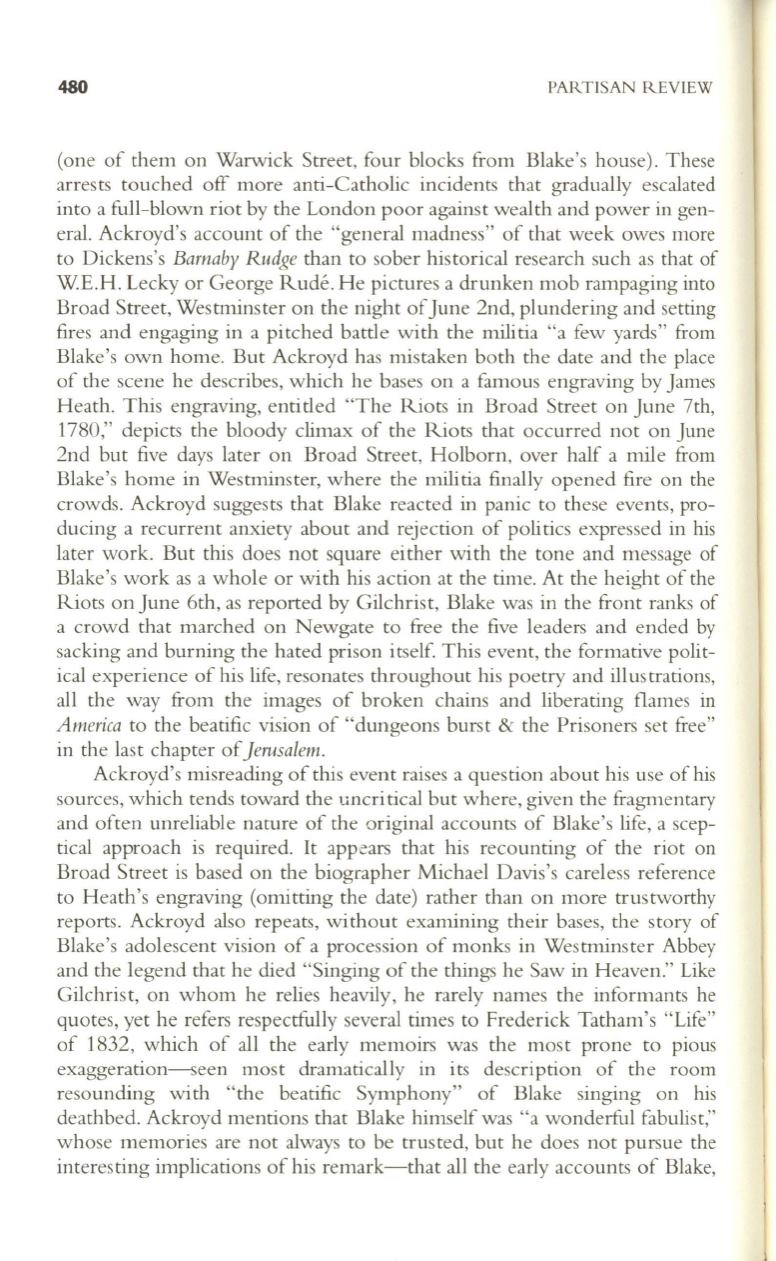
480
PARTISAN REVIEW
(one of them on Warwick Street, four blocks from Blake's house). These
arrests touched off more anti-Catholic incidents that gradually escalated
into a full-blown riot by the London poor against wealth and power in gen–
eral. Ackroyd's account of the "general madness" of that week owes more
to Dickens's
Barnaby Rudge
than to sober historical research such as that of
WE.H. Lecky or George Rude. He pictures a drunken mob rampaging into
Broad Street, Westminster on the night ofJune 2nd, plundering and setting
fires and engaging in a pitched battle with the militia "a few yards" from
Blake's own home. But Ackroyd has mistaken both the date and the place
of the scene he describes, which he bases on a famous engraving by James
Heath. This engraving, entitled "The Riots in Broad Street on June 7th,
1780," depicts the bloody climax of the Riots that occurred not on June
2nd but five days later on Broad Street, Holborn, over half a mile from
Blake's home in Westminster, where the militia finally opened fire on the
crowds. Ackroyd suggests that Blake reacted in panic to these events, pro–
ducing a recurrent anxiety about and rejection of politics expressed in his
later work. But this does not square either with the tone and message of
Blake's work as a whole or with his action at the time. At the height of the
Riots on June 6th, as reported by Gilchrist, Blake was in the front ranks of
a crowd that marched on Newgate to free the five leaders and ended by
sacking and burning the hated prison itself. This event, the formative polit–
ical experience of his life, resonates throughout his poetry and ill us trations,
all the way from the images of broken chains and liberating flames
in
America
to the beatific vision of "dungeons burst
&
the Prisoners set free"
in the last chapter of
Jerusalem.
Ackroyd's misreading of this event raises a question about his use of his
sources, which tends toward the uncritical but where, given the fragmentary
and often unreliable nature of the original accounts of Blake's life, a scep–
tical approach is required.
It
appears that his recounting of the riot on
Broad Street is based on the biographer Michael Davis's careless reference
to Heath's engraving (omitting the date) rather than on more trustworthy
reports. Ackroyd also repeats, without examining their bases, the story of
Blake's adolescent vision of a procession of monks in Westminster Abbey
and the legend that he died "Singing of the things he Saw in Heaven." Like
Gilchrist, on whom he relies heavily, he rarely names the informants he
quotes, yet he refers respectfully several times to Frederick Tatham 's "Life"
of 1832, which of all the early memoirs was the most prone to pious
exaggeration-seen most dramatically in its description of the room
resounding with "the beatific Symphony" of Blake singing on his
deathbed. Ackroyd mentions that Blake himself was "a wonderful fabulist,"
whose memories are not always to be trusted, but he does not pursue the
interesting implications of his remark-that all the early accounts of Blake,


